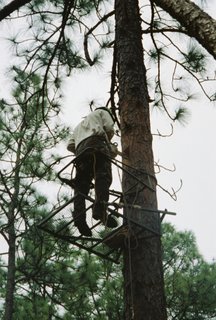
With chainsaw, biological science tech Greg Boling installs an artificial cavity nest for a red-cockaded woodpecker.
“Because We Can”
(In this excerpt, I accompany Laura Housh, field biologist, and Greg Boling, biological science tech, on a field trip to install artificial cavity nests for red-cockaded woodpeckers.)
Why do this at all, I asked Laura Housh, a wildlife biologist at the Carolina Sandhills refuge. Why not let the RCWs make their own cavity nests?
“It can take them a year to make a natural cavity. Because the birds are endangered, if we lose one or two active cavities, it could compromise the family.”
But why should humans care about red-cockaded woodpeckers? Why all this trouble and expense?
“First of all," Laura said, "they are endangered and by law were required to protect them. Also, we’re the reason they are endangered. It’s our responsibility to make sure they can thrive in their natural habitat. I mean, why save an endangered species? Because we can." . . .
I love this time of year,” she added as we walked back to the truck. “The most satisfying thing is to install artificial cavities for recruitment clusters, come back the next year, and find RCWs nesting in them. That’s the best.”

1 comment:
Aaron,
"Wing-cut marble flooring"--that's good.
I'd say there are two reasons why it takes so long. First, RCWs are the only woodpeckers to dig cavity nests into living trees--and their tree of choice is the longleaf pine, the pine that produces more sap than any other. Think of the sap ducts as veins. Each time one is cut, the bird must wait till it "coagulates" or seals. Also, RCWs excavate cavities into the heartwood, typically the hardest wood in the tree, although the cagey little birds appear to have a strategy for dealing with this . . .
You might wonder why RCWs pick such troublesome trees for homes. Forests in the Southeastern US endure more lightning-strike fires than any other forests on the continent. When a fire sweeps through, the safest place to be is often high up in a fire-resistant longleaf.
Den
Post a Comment